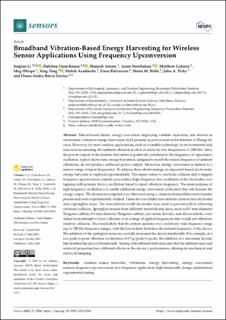| dc.contributor.author | Li, Jinglun | |
| dc.contributor.author | Ouro-Koura, Habilou | |
| dc.contributor.author | Arnow, Hannah | |
| dc.contributor.author | Nowbahari, Arian | |
| dc.contributor.author | Galarza, Matthew | |
| dc.contributor.author | Obispo, Meg | |
| dc.contributor.author | Tong, Xing | |
| dc.contributor.author | Azadmehr, Mehdi | |
| dc.contributor.author | Halvorsen, Einar | |
| dc.contributor.author | Hella, Mona M. | |
| dc.contributor.author | Tichy, John A. | |
| dc.contributor.author | Borca-Tasciuc, Diana-Andra | |
| dc.date.accessioned | 2023-06-05T10:58:06Z | |
| dc.date.available | 2023-06-05T10:58:06Z | |
| dc.date.created | 2023-06-03T10:23:18Z | |
| dc.date.issued | 2023 | |
| dc.identifier.citation | Li, J., Ouro-Koura, H., Arnow, H., Nowbahari, A., Galarza, M., Obispo, M., Tong, X., Azadmehr, M., Halvorsen, E., Hella, M. M., Tichy, J. A. & Borca-Tasciuc, D.-A. (2023). Broadband Vibration-Based Energy Harvesting for Wireless Sensor Applications Using Frequency Upconversion. Sensors, 23(11), Artikkel 5296. | en_US |
| dc.identifier.issn | 1424-8220 | |
| dc.identifier.uri | https://hdl.handle.net/11250/3069911 | |
| dc.description.abstract | Silicon-based kinetic energy converters employing variable capacitors, also known as electrostatic vibration energy harvesters, hold promise as power sources for Internet of Things devices. However, for most wireless applications, such as wearable technology or environmental and structural monitoring, the ambient vibration is often at relatively low frequencies (1–100 Hz). Since the power output of electrostatic harvesters is positively correlated to the frequency of capacitance oscillation, typical electrostatic energy harvesters, designed to match the natural frequency of ambient vibrations, do not produce sufficient power output. Moreover, energy conversion is limited to a narrow range of input frequencies. To address these shortcomings, an impacted-based electrostatic energy harvester is explored experimentally. The impact refers to electrode collision and it triggers frequency upconversion, namely a secondary high-frequency free oscillation of the electrodes overlapping with primary device oscillation tuned to input vibration frequency. The main purpose of high-frequency oscillation is to enable additional energy conversion cycles since this will increase the energy output. The devices investigated were fabricated using a commercial microfabrication foundry process and were experimentally studied. These devices exhibit non-uniform cross-section electrodes and a springless mass. The non-uniform width electrodes were used to prevent pull-in following electrode collision. Springless masses from different materials and sizes, such as 0.5 mm diameter Tungsten carbide, 0.8 mm diameter Tungsten carbide, zirconium dioxide, and silicon nitride, were added in an attempt to force collisions over a range of applied frequencies that would not otherwise result in collisions. The results show that the system operates over a relatively wide frequency range (up to 700 Hz frequency range), with the lower limit far below the natural frequency of the device. The addition of the springless mass successfully increased the device bandwidth. For example, at a low peak-to-peak vibration acceleration of 0.5 g (peak-to-peak), the addition of a zirconium dioxide ball doubled the device’s bandwidth. Testing with different balls indicates that the different sizes and material properties have different effects on the device’s performance, altering its mechanical and electrical damping. | en_US |
| dc.language.iso | eng | en_US |
| dc.rights | Navngivelse 4.0 Internasjonal | * |
| dc.rights.uri | http://creativecommons.org/licenses/by/4.0/deed.no | * |
| dc.title | Broadband Vibration-Based Energy Harvesting for Wireless Sensor Applications Using Frequency Upconversion | en_US |
| dc.type | Peer reviewed | en_US |
| dc.type | Journal article | en_US |
| dc.description.version | publishedVersion | en_US |
| dc.rights.holder | © 2023 by the authors. | en_US |
| dc.source.volume | 23 | en_US |
| dc.source.journal | Sensors | en_US |
| dc.source.issue | 11 | en_US |
| dc.identifier.doi | https://doi.org/10.3390/s23115296 | |
| dc.identifier.cristin | 2151469 | |
| dc.relation.project | Norges forskningsråd: 273248 | en_US |
| dc.relation.project | National Science Foundation: 1609647 | en_US |
| dc.source.articlenumber | 5296 | en_US |
| cristin.ispublished | true | |
| cristin.fulltext | original | |
| cristin.qualitycode | 1 | |

